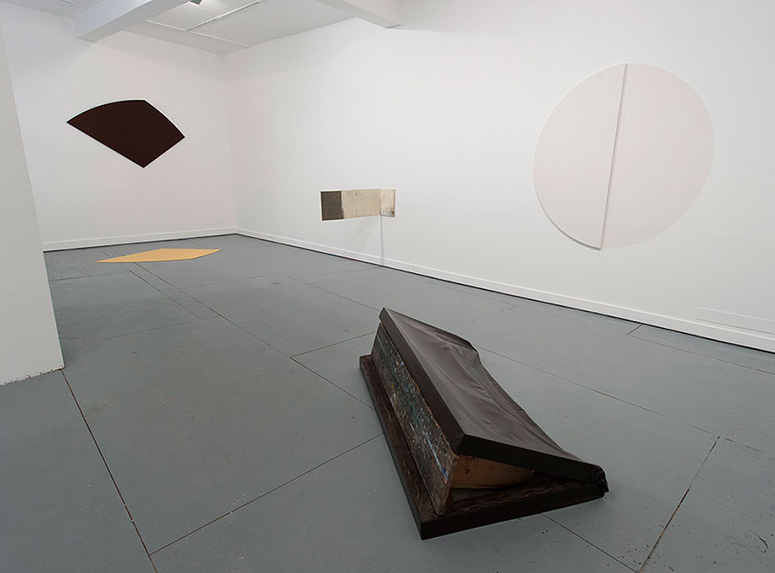
15 March – 10 May
by Ben Street
First, that title. Its literal meaning notwithstanding (from the Greek, for something like ‘going against the tide’), it’s a word that crawls through the mouth in slow motion. Words dunked in honey: apposite for a show about slowness, and one so resistant to a snap description. The tide that the works on display – by Onya McCausland, who has been exhibiting since the early 2000s, by Simon Callery and Angela de la Cruz, who both emerged during the 1990s, and by Australian born, Los Angeles-based Lawrence Carroll – go against is that of the image leached of embodiment. Each artist posits a counterstrategy. Even the visitor’s mode of engagement – peering, crouching, stooping – seems wilfully staged as a way of drawing a line between a passive receiving of the digitized image and the active mode of experiencing nature, say, or architecture. These are works for bodies, not eyes. That’s why language slows to a slouch.
Encountering a painting by Callery or de la Cruz – ‘looking at’ isn’t quite right – activates the viewing body by releasing information incrementally, in shadowed folds and hidden edges. Callery’s Foot-Neck Wallspine (2012–3) is a structure made of folded canvas projecting from hidden supports in the wall, apparently hovering a few inches from the floor. Entirely stained in dark green distemper, the work elides the distance between colour and effect, between surface and support. Its physical scale, keyed to the artist’s own, is complemented by de la Cruz’s Bloated III (Blue) (2012), a work similarly scaled to the artist’s standing height. A wall-mounted rectangular aluminium form, hammered into bulges from the inside and coated in glossy oil paint, the work aligns two historical acts of modern painting: the bashed and the brushed. By positioning the act of painting as something intrinsically constructive – Callery exposes the wooden guts of the painted stretcher in Burnt Umber Painting Oolite (2012); de la Cruz folds a black-painted canvas over a wooden bench in Debris (2012) – these artists restore to painting its historical immediacy. This is painting as constructed surface, a collusion of thing and thought. The resonance is premodern: altarpieces, frescoes, cave walls.
In McCausland’s paintings, minerals dug up out of evocatively named locations (Oxted Quarry, Surrey; Todmorden Moor, Lancashire) are applied as raw pigment to off-kilter geometric surfaces in contrasting media (ply and aluminium). In Separation (2014), two wonky parallelograms reflect each other from the wall and the floor. Painted with identical iron oxide pigment in differing densities, the components of the work rethink colour as weight, both visual and physical. Likewise, in Carroll’s work, the quiddity of the painted object is staged in a series of architectural proposals. Untitled Table Painting (Yellow) (2008) is a circular slice of parquet floor, surmounted by a sheet of cardboard held aloft by a scrabble of wooden struts. Slathered on its surface are washes of pale ochre and blanched yellows, colours that approximate unprimed canvas. For Carroll, this edging backwards is a restatement of the basic values of painting’s presence. In his Hinge paintings (all 2013), the painted surface cantilevers out of the wall like a cocked thumb, claiming physical and intellectual space at once. Words fail. Dancing about architecture suddenly seems like a good idea.